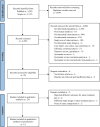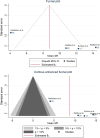Efficacy of conservative treatment for spastic cerebral palsy children with equinus gait: a systematic review and meta-analysis
- PMID: 36076293
- PMCID: PMC9461190
- DOI: 10.1186/s13018-022-03301-3
Efficacy of conservative treatment for spastic cerebral palsy children with equinus gait: a systematic review and meta-analysis
Abstract
Background: Comparisons between various conservative managements of spastic equinus deformity in cerebral palsy demonstrated limited evidences, to evaluate the efficacy of conservative treatment among cerebral palsy children with spastic equinus foot regarding gait and ankle motion.
Methods: Studies were identified from PubMed and Scopus up to February 2022. Inclusion criteria were randomized controlled trial (RCT), conducted in spastic cerebral palsy children with equinus deformity, aged less than 18 years, compared any conservative treatments (Botulinum toxin A; BoNT-A, casting, physical therapy, and orthosis), and evaluated gait improvement (Physician Rating Scale or Video Gait Analysis), Observational Gait Scale, Clinical Gait Assessment Score, ankle dorsiflexion (ankle dorsiflexion at initial contact, and passive ankle dorsiflexion), or Gross Motor Function Measure. Any study with the participants who recently underwent surgery or received BoNT-A or insufficient data was excluded. Two authors were independently selected and extracted data. Risk of bias was assessed using a revised Cochrane risk-of-bias tool for randomized trials. I2 was performed to evaluate heterogeneity. Risk ratio (RR), the unstandardized mean difference (USMD), and the standardized mean difference were used to estimate treatment effects with 95% confidence interval (CI).
Results: From 20 included studies (716 children), 15 RCTs were eligible for meta-analysis (35% had low risk of bias). BoNT-A had higher number of gait improvements than placebo (RR 2.64, 95% CI 1.71, 4.07, I2 = 0). Its combination with physical therapy yielded better passive ankle dorsiflexion at knee extension than physical therapy alone (USMD = 4.16 degrees; 95% CI 1.54, 6.78, I2 = 36%). Casting with or without BoNT-A had no different gait improvement and ankle dorsiflexion at knee extension when compared to BoNT-A. Orthosis significantly increased ankle dorsiflexion at initial contact comparing to control (USMD 10.22 degrees, 95 CI% 5.13, 15.31, I2 = 87%).
Conclusion: BoNT-A and casting contribute to gait improvement and ankle dorsiflexion at knee extension. BoNT-A specifically provided gait improvement over the placebo and additive effect to physical therapy for passive ankle dorsiflexion. Orthosis would be useful for ankle dorsiflexion at initial contact. Trial registration PROSPERO number CRD42019146373.
Keywords: Ankle; Cerebral palsy; Equinus; Gait; Management.
© 2022. The Author(s).
Conflict of interest statement
The authors report no conflict of interest.
Figures







Similar articles
-
Botulinum toxin type A in the treatment of lower limb spasticity in children with cerebral palsy.Cochrane Database Syst Rev. 2019 Oct 8;10(10):CD001408. doi: 10.1002/14651858.CD001408.pub2. Cochrane Database Syst Rev. 2019. PMID: 31591703 Free PMC article. Review.
-
A randomized controlled trial studying efficacy and tolerance of a knee-ankle-foot orthosis used to prevent equinus in children with spastic cerebral palsy.Clin Rehabil. 2014 Oct;28(10):1025-38. doi: 10.1177/0269215514542355. Epub 2014 Jul 31. Clin Rehabil. 2014. PMID: 25082956 Clinical Trial.
-
[Botulinum A in the treatment of equinus dynamic spasticity in children with cerebral palsy. Preliminary study].Rev Chir Orthop Reparatrice Appar Mot. 1999 May;85(2):156-63. Rev Chir Orthop Reparatrice Appar Mot. 1999. PMID: 10392416 Clinical Trial. French.
-
Botulinum toxin type A injections for treatment of spastic equinus in cerebral palsy: a secondary analysis of factors predictive of favorable response.Am J Phys Med Rehabil. 2010 Nov;89(11):865-72. doi: 10.1097/PHM.0b013e3181f1c5e7. Am J Phys Med Rehabil. 2010. PMID: 20736816
-
Effect of ankle-foot orthoses on gait, balance and gross motor function in children with cerebral palsy: a systematic review and meta-analysis.Clin Rehabil. 2018 Sep;32(9):1175-1188. doi: 10.1177/0269215518771824. Epub 2018 May 1. Clin Rehabil. 2018. PMID: 29714066
Cited by
-
A bibliometric analysis of cerebral palsy from 2003 to 2022.Front Neurol. 2024 Apr 2;15:1292587. doi: 10.3389/fneur.2024.1292587. eCollection 2024. Front Neurol. 2024. PMID: 38628701 Free PMC article.
-
Current Concepts in the Nonoperative Management of Achilles Tendon Pathologies: A Scoping Review.J Clin Med. 2025 Jul 4;14(13):4736. doi: 10.3390/jcm14134736. J Clin Med. 2025. PMID: 40649111 Free PMC article. Review.
References
-
- Stott NS. Cerebral Palsy. In: Rome K, McNair P, editors. Management of chronic conditions in the foot and lower leg. Edinburgh: Churchill Livingstone; 2015. pp. 214–250.
-
- Miller F Ankle Equinus in Cerebral Palsy. In: Miller F, Bachrach S, Lennon N, O'Neil M, editors. Cerebral Palsy. Cham: Springer; 2019. p. 1–24.
Publication types
MeSH terms
LinkOut - more resources
Full Text Sources
Medical

